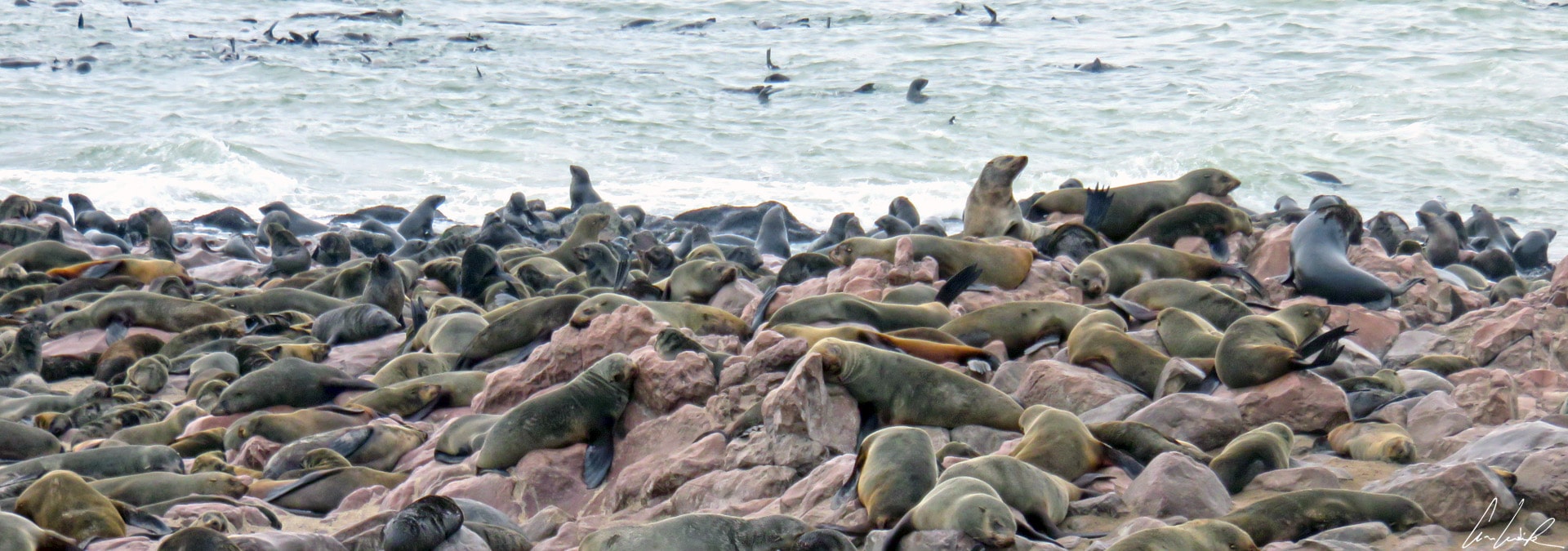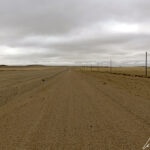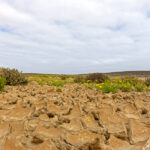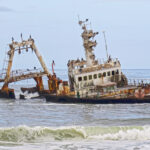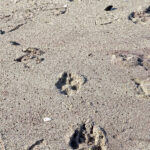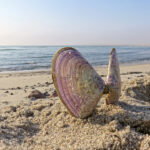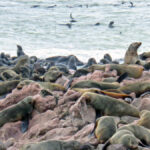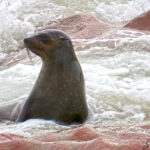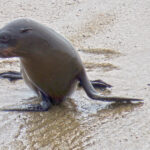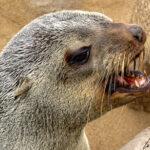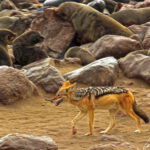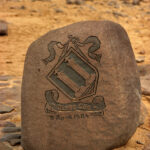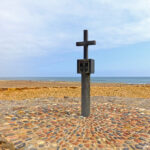After a long day driving through desert landscapes, we finally reach the ocean. Stunning waves of sand dunes undulate as far as the eye can see along the Atlantic Ocean. Here we are on the Skeleton Coast, the northern part of the Atlantic Coast of Namibia stretching south from the Kunene River on the border with Angola to the Swakop River in central Namibia. A narrow strip of dunes stretches 310 miles along the coast and 25 miles inland. There is something very different about this part of Namibia. Portuguese navigators once referred to it as « Areias do Inferno » (the Gate of Hell) because when a ship ran aground here, the fate of the sailors was sealed ! The San tribes call the region the « Land God made in Anger ». In other words, this territory is one of the most inhospitable in the world. Yet we, the adventurers, have dared to venture into this land where fog banks and the sand swirling in the wind create a real sense of loneliness and isolation
«Shamans say time is short,
The earth no longer wants these fine words,
You don’t understand, do as you please,
You’ll end up on the skeleton coast »
(Bernard Lavilliers – La Côte des Squelettes)
The mysterious Skeleton Coast: A desert of the living dead …
The « Skeleton Coast » probably owes its name to the many remains of beached whales and ships such as the fishing boat Zeila Shipwreck, now a simple refuge for cormorants. It is a dangerous coastline, often covered in dense fog due to the cold Benguela current. This current carries water from Cape Point in South Africa to the Angola-Benguela front in the north. The cold waters collide with the hot air off the coast of the Namibian desert. This extreme difference in temperature creates a thick fog that covers both coastline and ocean.
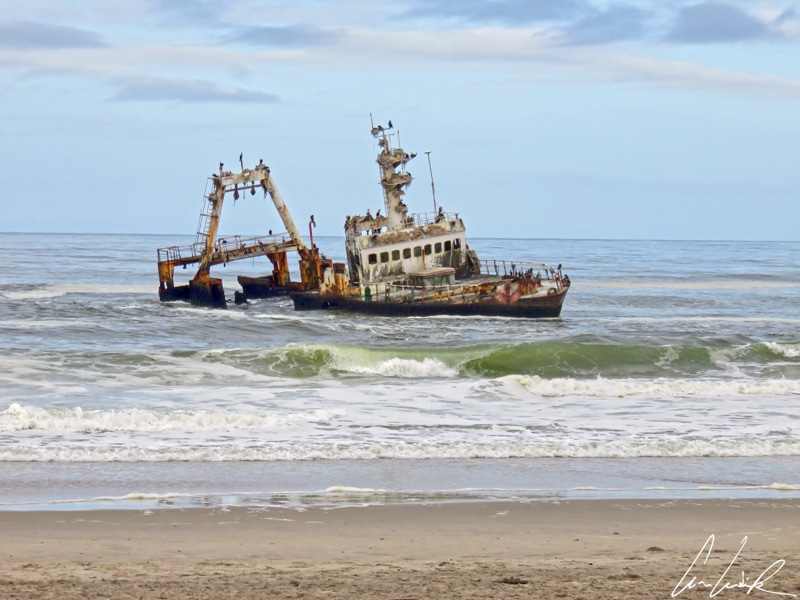
Many shipwrecks have been entirely destroyed by the sun, ocean, and wind, but some are still visible. A few are seemingly stranded in the middle of the desert, bearing witness to the advance of the desert into the ocean.
« The person who invented the ship also invented the shipwreck » (Lao Tseu)
The Eduard Bohlen, a German freighter shipwrecked in 1909, lies in the sand more than 550 yards from the shoreline. Another ship, the MV Dunedin Star, ran aground in 1942. She carried ammunition and supplies for the British Eighth Army in the Middle East and twenty-one passengers fleeing London and war. Bad luck and unfavorable conditions marked the complex sea, air, and land rescue operation. Nevertheless, the rescue efforts saved all passengers and crew members even though the tugboat sent as part of the operation ran aground and two of the tug’s crew were lost. A South African Air Force Lockheed Ventura bomber was sent to drop food on the beach for the survivors. After delivering its cargo to the crew and passengers of the distressed wreck, the Ventura landed on a salt pan and sank through the crusted surface where it has remained stuck ever since. The tugboat and the bomber are still visible today….
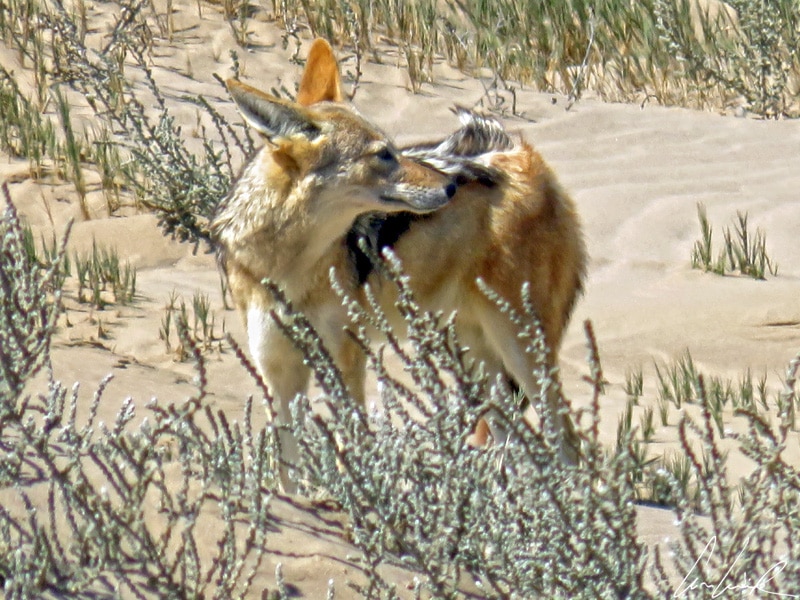
A protected area since 1971, the coast is home to amazingly diverse fauna. It is not uncommon to encounter, while wading through the sand waves, the Oryx gemsbok, the Springbok gazelle and the Black-backed jackal (Canis mesomelas). The latter is a fox-like animal easily recognizable by its reddish coat and the black saddle that extends from its shoulders to the base of its tail. From a scientific point of view, studies of fossils tend to show that the Black-jacked jackal is the oldest representative of the genus Canis and has changed little since the Pleistocene Age. On the coast, jackals patrol the beach: their footprints are easily recognizable in the wet sand! The jackal is probably the best of us when it comes to taking advantage of a situation. Is he also an opportuniste as French singer Jacques Dutronc sings so well ? Jackals feed on termites, wild fruits, small mammals such as mice and hares, and young antelopes. He is also a scavenger that feeds on the remains of animals killed by another predator. A jackal can smell carrion up to 8 miles downwind. What a hell of a nose is that ?
« A hungry belly has no ears, but he has a hell of a nose ! » (Le chat noir – Alphonse Allais)
The jackal also knows how to torment other predators, such as the spotted hyena (Crocuta Crocuta), in an attempt to steal a meal. However, the jackal rarely tries to steal a leopard’s leftovers as he is suspicious of its speed. The coast also has some 300 species of birds. But the undisputed stars of the place are the thousands of Fur seals at Cape Cross.
Cape Cross Seal Reserve: thousand of Fur seals
Cape Cross Seal Reserve covers 23 square miles and is home to the largest of the 23 Fur seal colonies in southern Africa. Despite an attractive beach that stretches as far as the eye can see, forget your beach towel and bathing suit. Although we are by the ocean, Cape Cross beach is already occupied by hundreds of thousands of Fur seals (Arctocephalus pusillus.) The rocks and ocean are overrun with lounging Fur seals. For the record, the French name for sea lion, « otarie », comes from the Ancient Greek ὠτάριον « ōtárion », which means « little ear ». Unlike seals, which have a hole in the back of their eyes, sea lions have very visible external ear flaps (pinnae). These thousands of Sea lions offer a unique atmosphere, a show both fascinating and repulsive, their screams and nauseating smell somewhat break the charm of the ocean. Of our five senses, smell and hearing are put to the test… If you have a sensitive sense of smell, a little tiger balm under your nostrils will do you good…

The Cape Cross Fur seal has a large and broad head with a pointed snout. Males are larger than females and measure up to 7 feet in length and weigh between 450 and 700 pounds. Females are about 6 feet long and weigh up to 260 pounds. Adults have a light belly while females have a light throat with a darker back and belly. Under the first layer of coarse hair, these brown Fur seals have a dense and thick underfur that remains dry and insulates the animal from the cold and humidity. This underfur allows the Fur seal to maintain a temperature of 98.6°F and spend extended periods in cold water. The insulating fur allows the seal to hunt among the large concentrations of fish present in the icy waters of the Benguela current. The Cape Fur seal can dive as deep as 650 feet and remain underwater as long as 7 minutes. A Fur seal consumes 8% of its weight in food every day! Its diet is 70% fish. Once in the water, the Fur seal moves quickly to fish and play in the endless waves. We spend a long time watching them fish in these cold waters. Once the fishing is over, the Fur seal returns to the beach to dry quietly in the sun.
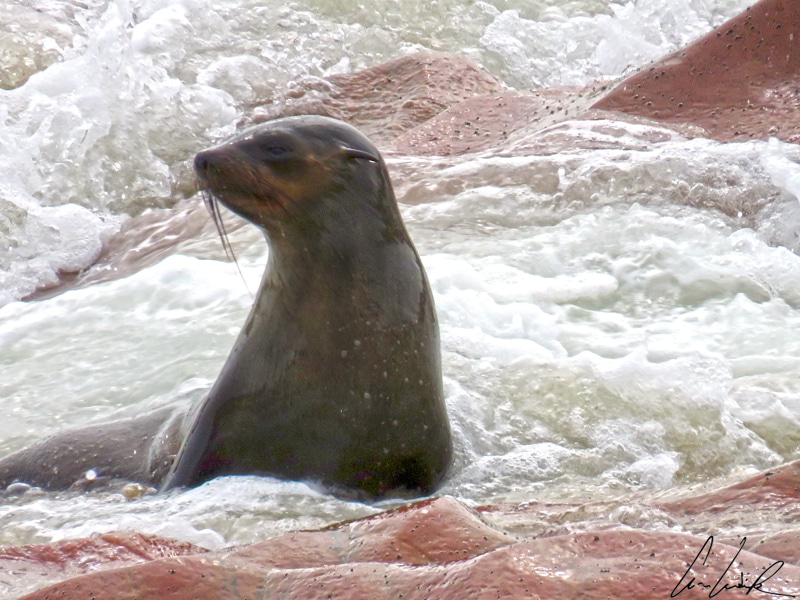
The Namibian Fur seal lives in large colonies, but is very antisocial. The males are vocal and always quarreling to defend and establish territory. Territory is hard-won through strength and often after combat. A male’s territory includes several females. A harem can number about 50 females. But unlike many other Fur seal species, males do not herd the females, who are free to choose their mates according to the value of their territory… Females often weigh only about 170 lbs and give birth after a nine-month gestation to a single pup. Except for the young pups, born between November and December (in the middle of the austral summer), who play together, almost all relationships between individual seals are hostile. This Fur seal, for example, looks to be in a rage! As the French singer Pierre Perret said:
« When you have a grudge against someone, it is useless to mince your words » (Pierre Perret)
For the moment, any resemblance to another species in the animal kingdom would be purely fortuitous ! The colony allows for reproduction and protects individuals from predators. It is not uncommon to encounter Black-jacketed jackals and Brown hyenas trying to chase the weakest or the youngest… The pup mortality rate is 25%, mainly due to such land-based predators.
The stone cross of Cape Cross back in Namibia
Cape Cross is particularly interesting not only for its Fur seals but also historically. It reminds us of the great maritime epics of the 15thcentury. Under the reign of King John II of Portugal, called the Perfect prince (like the liver pâté in tube, a 100% Swiss specialty), the search for a new route to India was an absolute priority. Portuguese explorer Diogo Cão sailed with ships carrying with stone pillars surmounted by the Cross of the Order of Christ, carved out of rock from the Lisbon quarries. These crosses were engraved with the Portuguese royal arms (padrãos), with the intent to erect one in every new territory claimed and to serve as navigational markers. They measured about 10 feet high and weighed more than a ton. They represented both the power of the kingdom of Portugal (with its Portuguese emblem) and that of the Christian faith (with its Christian cross). In 1486, the ships reached the mouth of the Kunene Riverand then followed the Skeleton Coast to about 87 miles north of the present-day town of Swakopmund. At the end of his strength and hope in this desolate landscape and beaten by the winds and thick mists worthy of the darkness of Erebia, Diogo Cão erected his cross on April 8, 1486, and immediately returned to Portugal without accomplishing the goal of his journey. This date marks the birth of Cape Cross, which is the southernmost point of Africa discovered by Europeans. The inscription engraved on the stone cross (padrão) erected to mark the location of the Cape reads, in English translation,
« In the year 6685 after the creation of the world and 1485 after the birth of Christ, the brilliant, far-sighted King John II of Portugal ordered Diogo Cão, knight of his court, to discover this land and to erect this padrão here »
The original Cape Cross padrão came into Germany’s possession in 1893, when Captain Gottlieb Becker, commander of the SMS Falke discovered the artifact. He ordered its removal and returned with it to Wilhelmshaven and placed it in a Berlin museum. A simple wooden cross was put in its place and replaced two years later by a stone replica. Then a second cross was erected. The crosses we see today are, therefore, two replicas.
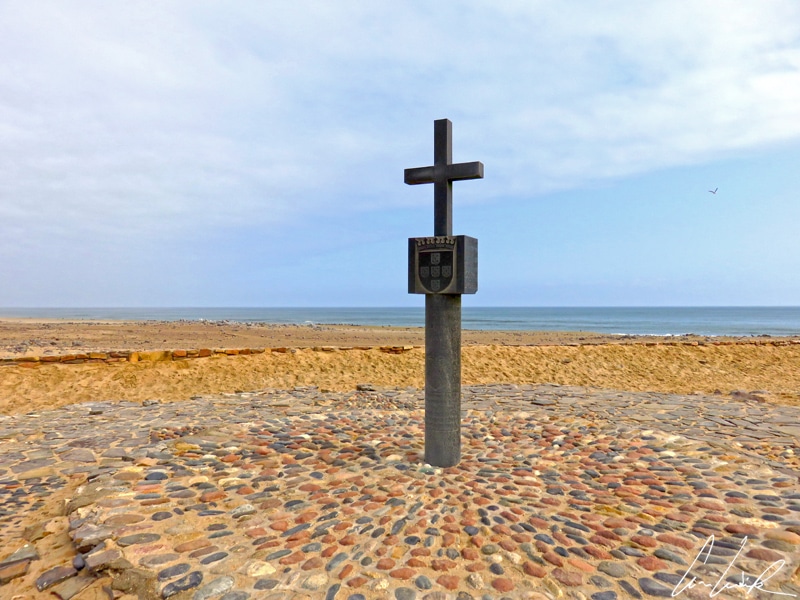
More than 120 years after its transport to Germany, Namibia will finally recover its stone cross! Monika Grütters, Germany’s Secretary for Culture and Media, said at a press conference at the German Museum of History, « The return of the stone cross of Cape Cross is a clear signal that we recognize our colonial past and that we are seeking and finding along with the countries of origin, the means to have a respectful coexistence ». If Germany’s memory work on the Nazi period is generally considered exemplary, the same has not been true for Germany’s colonial period in Africa, from the second half of the 19th century to the beginning of the 20th century, which has long been neglected… Things have begun to change in recent years with the restitution of human remains taken during African colonization. The future return of the Stone Cross of Cape Cross is the latest episode in Berlin’s desire to put its colonial past behind it.
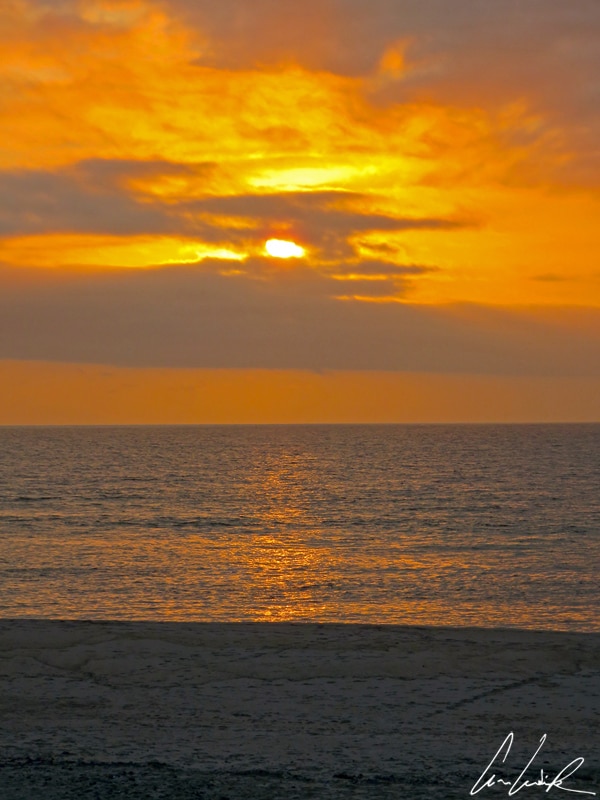
We end the day with a beautiful sunset over the Atlantic Ocean. Happy as Ulysses, we have seen hundreds of landscapes… and feel grateful to experience these exceptional moments. They are a few places in the world where you can enjoy such a feeling of loneliness and isolation…
« With sun and wind / With rain and good weather / we were living happily » (Heureux qui comme Ulysse – Georges Brassens)
Find more on Namibia
- Waterberg Plateau Park !
- Lake Otjikoto, a lake that digs its own hole !
- A glimpse of Etosha National Park
- In the heart of the Etosha National Park wildness
- Etosha National Park: A journey to the Animal Kingdom
- Epupa Falls: rendezvous in Himba land
- Encounter with Desert Elephants and Welwitschia Mirabilis
- The Petrified Forest and Rock Carvings of Twyfelfontein
- Walvis Bay:Rendezvous with Desert and Ocean
